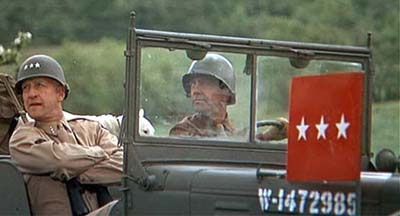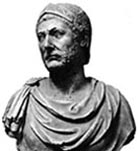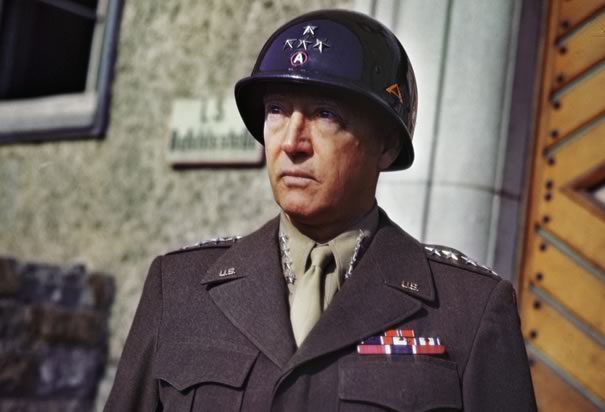 Submitted by Glorious Bastard on
Submitted by Glorious Bastard on

Article by Reverse Spins Editor http://www.reversespins.com
PATTON: Movie Script: Dialogue taken from movie.
SCENE:
Three men in W.W. II uniforms (two Generals) traveling down a North African road in a jeep.
DIALOGUE:
General George S. Patton (George C. Scott): "Hold it! Turn right here."
Driver: "But sir, the battlefield is straight ahead."
Patton: "Please don't argue with me Sergeant. I can smell a battlefield."
General Omar Bradley (Karl Malden): " He was out here just yesterday George."
Patton: (points with his riding crop) "It's over there, turn right, damn it!"
SCENE:
The jeep goes off road, passing some turbaned North Africans on donkeys and then comes upon some Romanesque ruins. Patton gets out, followed by Bradley. A haunting echo of horns plays in the background as if replaying some ancient charge of a long forgotten battle.
DIALOGUE:
Patton: "It was here. The battlefield was here. The Carthaginians defending the city were attacked by three Roman Legions. Carthaginians were proud and brave but they couldn't hold. They were massacred. Arab women stripped them of their tunics and their swords and lances. The soldiers lay naked in the sun, two thousand years ago; and I was here."
SCENE:
Patton, on bended knee, pauses, smiles knowingly, turns to a sometimes bemused Bradley and says:
DIALOGUE:
Patton: "You don't believe me, do you Brad? You know what the poet said,
'Through the travail of ages,
midst the pomp and toils of war,
have I fought and strove and perished,
countless times among the stars.
As if through a glass and darkly,
the age old strife I see,
when I fought in many guises and many names,
but always me.'" *Patton: "Do you know who the poet was?"
Bradley [Smiles slightly and shakes his head, no.]
Patton: "Me."

A particularly evocative scene from the movie Patton, is it not? You get the sense that he actually remembers the terrible scene of his fallen comrades. But what of his modern day army, those men he led in World War II. Tens of thousands of them willingly trusted his judgement in battle. Would they also follow him in matters of the Spirit. Would those who believe he was brilliant in battle also believe that that insightfulness can be brought to bear in other areas of life. George Patton believed in reincarnation. He remembered fighting the Romans as a Carthaginian. Patton also believed he was with Napoleon (I believe he was the flamboyant and daring Marshal Ney* but that theory is best left for another day).
I will make the case that one of America's greatest Generals, Patton, was one of history's greatest Generals, Hannibal; through parallels (habits ingrained) and lessons learned (opposite courses of action). Many can be explained as coincidences but then, if there is such a thing as reincarnation, 'there are no accidents.' Do great Generals just sprout up or maybe they are made over countless lifetimes, perfecting and honing their abilities. You be the judge:
1. Both grew up in wealthy families and lived near a large body of water, the Pacific and Mediterranean.
2. "I swear that so soon as age will permit . . . I will use fire and steel to arrest the destiny of Rome." - a very young Hannibal Barca said standing next to his father, before an altar. George Patton decided during childhood that his goal in life was to be a hero in the mold of ancient Greek heroes. His father read to him Homer's Iliad and Odyssey until the boy could recite the lines himself.
4. Both entered the infantry. Patton had several other choices. Hannibal had only two. Carthage was a famous seafaring city also.
5. Both cut their teeth in battle in a Spanish speaking country. Patton in Mexico and Hannibal in Spain.
6. Both were enamored with the use of heavy armor. Patton with his tanks and Hannibal utilized armor plated elephants like no one before or since although they were often ineffective. He must have been pretty pleased with the new innovation of tanks.
7. Hannibal's final defeat happened in North Africa. Patton joins WWII by landing in North Africa. He rectifies the karmic record by winninng his first major engagement.
8. The Roman Consul, Scipio, studied Hannibal's tactics to finally defeat him at Zama (Among some of these were the use of horns which were blown to scare the charging elephants into retreat, causing havoc in the advancing Carthaginian lines.) Patton studied Rommel's book and tactics to defeat his Panzer battalion in North Africa. It would be an ironic case of karmic justice if Rommel and Scipio were one and the same.
9. Hannibal led one of the greatest, if not 'the greatest' march in history. With approximately 60,00 men, 20,000 or so calvalry and 100 elephants, he started from Spain; crossed the Rhone River in France; then crossed the Alps in winter to attack Italy from the north. Patton was famous for getting his troops to move faster and beyond the expectations of both the allies and the enemy. His Third Army 'end run' through France is a prime example. By 'coincidence' the longest terrain Hannibal had to cross was France as well.
10. Both of them would find ways to overcome obstacles that would stop others in their tracks, literally. They were both adept at crossing rivers. When crossing the Rhone, Hannibal created a gigantic raft covered in dirt and plants to fool the elephants into getting on board. It worked. In a War Game before W.W. II, Patton had to cross rivers without using any existing bridge. A lieutenant came upon a tank sitting in a stream with only its turret showing. Patton said to him, "Their speed was not high enough when they hit the water. I'm sure they could float all the way across the stream if they had hit the water at top speed! We gotta be able to cross this kind of stuff without bridges. It takes too much time to build a pontoon bridge for these little streams." He then proceeded to back up his tank 100 yards. The driver gunned it with only Patton sticking out of the turret. Patton braced himself as the impact created a great splash. The tank floated for a moment, the engine sputtered and the tracks finally caught hold on the other side, lifting the drenched tank to the opposite bank. From General Patton's Principles by Porter Williamson (the lieutenant).
11. There are two of Patton's principles the above author learned from that experience. They are in Patton's words: "We can always learn from each other.You watch me cross this stream.You taught me that you reserve officers can solve problems. Let me show you how to get a tank across a river!" and "Always do everything you expect of the men you command." These principles are perfectly consistent with the M. O. of Hannibal. He was with the men every step of the way from Spain, into the Alps and on to the plains of Italy, sharing their difficulties and triumphs. ibid.
12. Hasdrubal, Hannibal's brother (sometimes described as his brother-in-law) comes from Spain, crosses France and the Alps to aid Hannibal; only to be defeated and killed almost immediately upon entering Italy. His head is sent to Hannibal's camp. This had to be a devasting series of events for Hannnibal. First, he did not know that Hasdrubal was coming to his aid. When he did find out, couriers were constantly being intercepted by the Romans. He did not know the true situation and so decides to wait in the south. The loss of Hasdrubal's 30,000 man army signaled a change in the fortunes of Hannibal. The unexpectant arrival of Hasdrubal's head must have been unnerving. Could it have had such an emotional impact that it would cloud his judgement in a future life? Patton's worst fiasco of the war was his ill-conceived plan to liberate the prisoners of war in a prison camp at Hammelburg, Germany. He did not have enough intel. Not enough troops were sent. Not only were the prisoners recaptured, the troops he sent were captured also. Why the error in judgement? His son-in-law was a prisoner in that camp. Could this be the hidden cause and effect behind a failed mission that has baffled historians to this day?
13. Hannibal spent about 17 years trying to subdue Rome. In retrospect, his greatest error was in not attacking Rome directly. Some experts say he lacked siege equipment therefore he didn't try; or that he didn't want to destroy Rome, just split off city-states to reduce its power. It would be his undoing. Patton, having learned from that mistake over 2,000 years ago, was relentless in forging ahead whenever he attacked. First he raced Monty to Messina and probably would have finally been able to attack Rome, 2,000 years later, through Anzio if not for the infamous 'slapping' incident. He did prove for the first time in WW II that the Americans were a highly effective fighting force. When he resumed command, he made a beeline for Berlin. They had to slow him down in fact. FDR had promised Stalin Eastern Europe. If Third Army liberated Eastern Europe before the Soviets, it would have been difficult to let those countries become communist.
14. Elephants turned back on his own troops help to defeat Hannibal at Zama. Lack of gasoline slowed down Patton's heavy armor.
15. Both fought martial, warlike States.
16. Hannibal's foe, Rome was ultimately defeated by Germanic tribes. Patton beat the Germans. I'm not sure of the karma but it is interesting.
17. For a short while after his defeat, Hannibal ruled Carthage with democratic principles trying to reduce the power of the oligarchy. That didn't sit well with the powers that be. He was forced to leave. Patton refused to blindly condemn all Germans, even all the S.S. He was only interested in punishing the powers that be and the corrupt Nazis. Needless to say, this put him at odds with the Press and his own top Brass.
18. Both were an anathema to ruling Governments once the fighting stopped. Hannibal was hounded all across the Mediterranean once he was forced to leave Carthage. Patton was a duck out of water in administering to the conquered land.
19. They both died a strange death. Chased till he could take it no more, Hannibal committed suicide. Patton died an innocuous death in a minor traffic accident. Many believe to this day there was foul play.
20. Both had an endearing personality and charisma to spare. Although each undoubtedly had a strong ego, their men would follow them anywhere. Indeed, no one has ever matched Hannibal's ability. He kept a massive force of mercenaries together for over 15 years, on foreign soil without one mutiny.


21. Now look again at the two pictures above, but this time more closely. Compare the mouth, chin, nose and eyes. The bust of Hannibal dates to about the second Punic War. It was originally found at the ancient city-state of Capua in Italia. Capua was closely allied to the general, was no doubt intended to be the Carthaginian political representative in Italy, and possibly commissioned the bust in honor of him. It also corresponds well with Carthago-Phoenicians coins and may be said to be a true likeness of Hannibal. (thanks to Jarad Reilly for this info on the bust) In addition, artists and sculptors sometimes have a knack for tuning into the soul of an individual, capturing the true essence of the man.
For more go to:
http://www.reversespins.com/patton.html

- 5076 reads